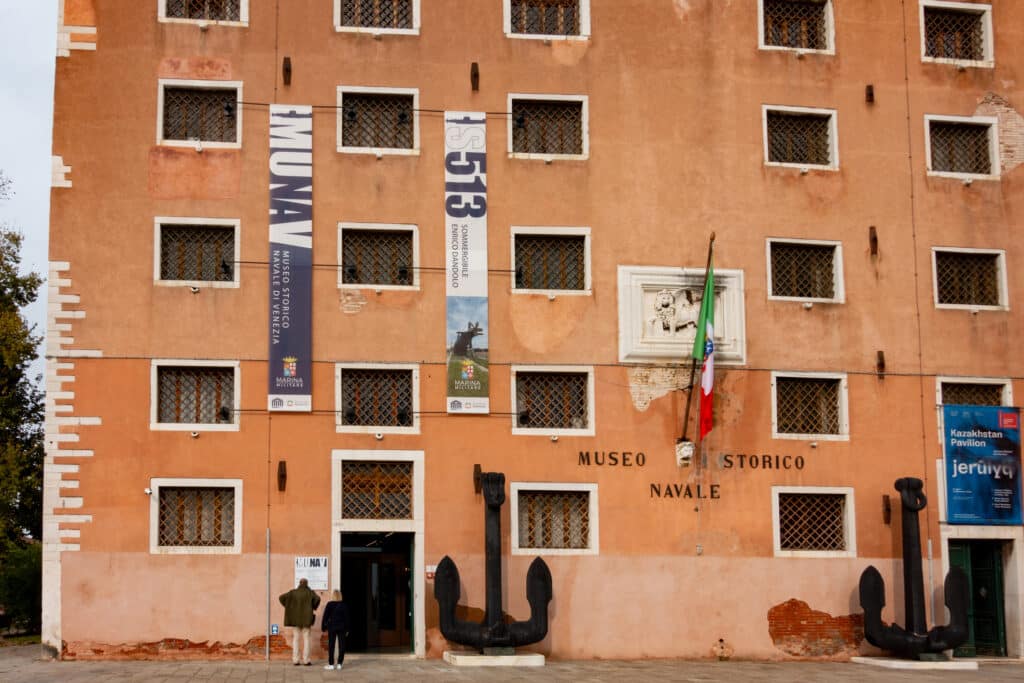
The Naval History Museum in Venice (Museo Storico Navale) has an admission fee of €16 for adults in 2025, which now includes an audio guide in the ticket. Discounted tickets are available: seniors (65+), students, and young adults (15–26) pay €12, while children aged 6–14 and local residents pay €8. Even better, little ones under 6 years old enter free of charge.
The museum is open daily from 10:00 AM, with seasonal closing times – it stays open until 6:00 PM during the spring/summer period (March 21 – November 4) and until 4:00 PM in the winter season (November 5 – March 20). Note that the museum is closed on Tuesdays year-round, so plan accordingly. We visited the Naval History Museum on June 23, 2025, and all the above information was accurate as of that date.
A Journey Through Venice’s Maritime Heritage
Stepping inside the Naval History Museum, we felt as if we were setting sail into Venice’s maritime past. The museum is housed in a historic waterfront building near the Arsenal – in fact, this very structure was once a granary of the Serenissima (the Venetian Republic) and today remains under the Navy’s jurisdiction. Spread across multiple levels (the main exhibit halls historically spanned five floors), the museum’s scope is impressive; its collection spans centuries of seafaring history, from Renaissance galleys to 20th-century battleships. Ever wondered how Venice became a maritime powerhouse? This is the place to find out. The exhibits cover everything from ornate scale models of famous Venetian ships and detailed naval maps to vintage weapons and sailors’ uniforms.
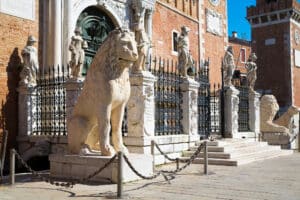
Arsenal and Naval Museum entrance
We were particularly drawn to the legendary highlights – for example, the museum displays remnants and models of the Bucintoro, the Doge’s lavish ceremonial barge used during Venice’s “Marriage of the Sea” ceremony. It’s definitely a centerpiece of the collection, glittering with gold accents and rich with history. Besides the Bucintoro, you’ll also see traditional Venetian lagoon boats (gondolas, fishing boats, and the like), shipwrights’ tools, and even the actual engine room telegraph from Guglielmo Marconi’s yacht Elettra – a fascinating slice of naval technology.
As we wandered through the halls, we found the atmosphere immersive – almost as if the creaking wood floors and faint smell of the sea were whispering old maritime tales. Why is this museum so significant? Venice was one of the great naval powers in history, and the Naval History Museum (recognized as the most important museum of its kind in Italy) captures that legacy in vivid detail. We learned about naval battles, trade routes, and shipbuilding techniques that once made the Venetian Arsenal the envy of Europe. In one section, tattered battle flags and maps from the Battle of Lepanto era caught our eye, while elsewhere we found a beautifully crafted model of an 18th-century frigate. The curation is informative but not overwhelming; most exhibits have English and Italian descriptions, and the new audio guide is excellent for deeper context.
We spent around two hours inside and were never bored – in fact, we lost track of time among the 42 exhibition rooms of artifacts. The experience was enlightening and engaging, mixing education with a sense of adventure. If you prefer a guided experience, the museum also offers guided tours (we noticed scheduled group tours in a couple of galleries), but exploring at your own pace works just as well thanks to the clear layout and audio commentary.
One feature you should not miss – and indeed cannot miss, as it’s huge – is the Enrico Dandolo submarine parked just outside in the Arsenal basin. This real Italian Navy submarine, 46 meters long, is part of the museum visit with a separate combined ticket and is accessible only via guided tour at fixed times. We joined one of the submarine tours (offered in English and Italian) and found it absolutely fascinating.
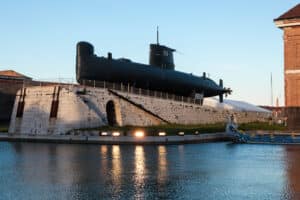
The Enrico Dandolo Submarine – Venice Naval History Museum
Ducking through the hatch, we entered the narrow confines of the Cold War-era submersible. An expert guide (an Italian Navy veteran) walked us through the control room, periscope station, and crew quarters. It was thrilling to imagine the submarine’s patrols – though as the guide explained, these Type Sauro submarines fortunately never had to fire a torpedo in conflict. The tour answered questions we didn’t even know we had: How did sailors live packed in this tube under the sea? Where did they eat and sleep? The guide’s stories really brought it to life.
We recommend including the submarine in your visit if time permits – it was a highlight for us. The upgrade to a Museum + Submarine ticket costs a bit extra (combined adult ticket is €26 as of 2025), but in our opinion it was worth it for the added insight. By the end of the museum and submarine tour, we felt we had traveled through centuries of naval history, all in the span of an afternoon.
Exploring the Neighborhood: More to See and Taste Nearby
Wondering what else you can do once you navigate out of the Naval Museum? The surrounding Castello district is full of its own quiet charms and historical spots. Right next door is the sprawling Venetian Arsenal itself – the very shipyard that powered Venice’s naval dominance. You can’t freely enter most of the Arsenal (it’s still a working naval area), but we strolled up to the famous Porta Magna (the Arsenal’s grand gate) guarded by stone lions. Peeking through the gates gives you a sense of the scale of this 12th-century shipyard, which at its peak could reportedly outfit a sailing ship in a single day.
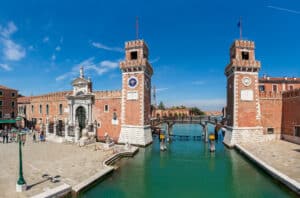
View of famous Arsenal of Venice
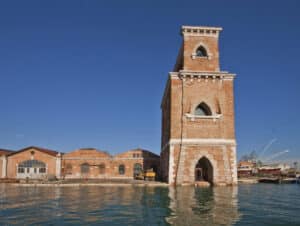
Venice, Arsenal, powder house.
Just south of the museum, along the quayside, you’ll also come across the Church of San Biagio (look for a small white marble facade). This 11th-century church was once the chapel of Venetian sailors and later the Austrian Navy; today it’s used by the Italian Navy for ceremonies and occasionally houses additional naval exhibits. It was closed during our evening walk, but knowing its backstory added an extra layer of context to the area – another reminder that around here, every building has a story connected to the sea.
After a dose of history, you might crave a change of pace (or a snack!). We recommend wandering a few minutes east to Via Garibaldi, one of Venice’s widest streets and a local favorite in Castello. This bustling avenue, surprisingly free of tourist crowds, is lined with cafés, bakeries, and small shops. We stopped for a scoop of gelato and enjoyed people-watching as neighborhood residents did their evening shopping – a refreshing break from museum-going.
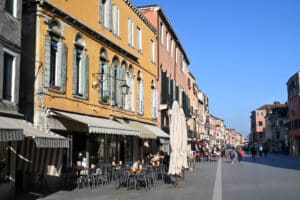
Via Garibaldi with bars and restaurants
If you’re ready for a meal, the area offers some excellent traditional eateries. In fact, we capped our museum visit with a late lunch at Ristorante Bacarandino dal 1974, a cozy restaurant tucked in a side street (Calle Crosera). Their seafood cicchetti and risotto al nero di seppia (squid ink risotto) were a delight – the kind of hearty Venetian cooking that hits the spot after hours of exploration. Another great option we found is La Nuova Perla, a family-run osteria renowned for its fresh fish dishes and friendly service. It’s just around the corner on Via Giuseppe Garibaldi, so you won’t have to wander far.
Before leaving the Castello area, consider taking a leisurely walk along the waterfront Riva degli Schiavoni towards the heart of Venice. In about 10–15 minutes you’ll reach the postcard-famous view of St. Mark’s Basin. We did this after our museum day, and watching the sunset over the lagoon was the perfect serene ending. Overall, visiting the Naval History Museum enriched our understanding of Venice beyond the usual art and architecture; it connects you to the city’s soul as a seafaring republic. It’s a place where history isn’t just seen – it’s felt.

